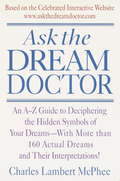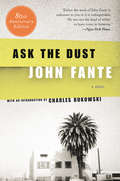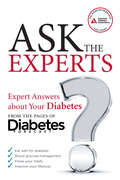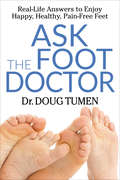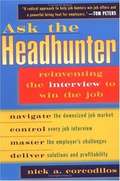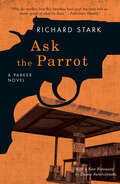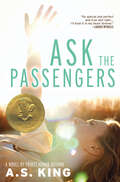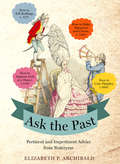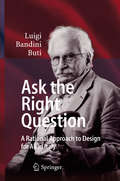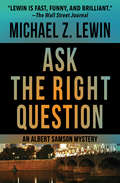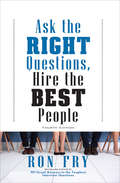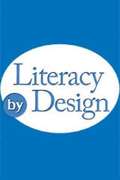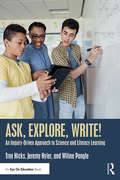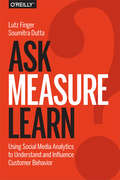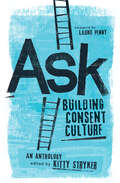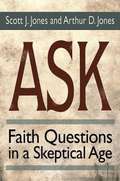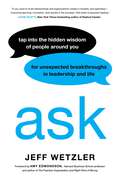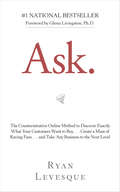- Table View
- List View
Ask the Dream Doctor
by Charles Lambert McpheeFrom Airplanes To Weddings, What Do Your Dream Symbols Really Mean? How many times have you awakened from an emotional dream convinced of its significance yet baffled by its practical meaning in your everyday life? In this remarkable book, dream doctor Charles Lambert McPhee, founder of the celebrated website askthedreamdoctor. com, helps you unlock the hidden meaning in your dreams and transform your waking life. Drawing on hundreds of thousands of dreams sent to his website, he provides expert interpretations based on years of expertise and experience. Alphabetized for easy reference, filled with more than 160 real-life dreams from people around the world,Ask the Dream Doctorwill help you unravel many common dream symbols, including: •Airplane Crash. . . Are your dreams precognitive? Are they warnings? •Car. . . Are you driving your own car [symbol of self]--or allowing someone else to drive it? Is the car in your dream "out of control"? • Chase Nightmares. . . What disturbing feelings are you trying to avoid? Are you procrastinating making a big decision? •House. . . What is your “dream” house like? It may reveal more about your true self than anything in your waking life. •Sex. . . It’s not always about the obvious. Discover what underlies one of the most common metaphors of all. •Tornado. . . Are you in an intense emotional or family conflict? Your dreams may be waking you up to something you haven’t recognized. •Water. . . Learn about the kind of dream that alerts you to see a sleep doctor immediately! From the Trade Paperback edition.
Ask the Dust ("rebel Inc. " Classics Ser. #17)
by John FanteAsk the Dust is a virtuoso performance by an influential master of the twentieth-century American novel. It is the story of Arturo Bandini, a young writer in 1930s Los Angeles who falls hard for the elusive, mocking, unstable Camilla Lopez, a Mexican waitress. Struggling to survive, he perseveres until, at last, his first novel is published. But the bright light of success is extinguished when Camilla has a nervous breakdown and disappears . . . and Bandini forever rejects the writer's life he fought so hard to attain.
Ask the Experts
by American Diabetes ADAEach month the editors of Diabetes Forecast publish answers to relevant questions submitted by readers. The answers, written by physicians, nurse practitioners, physician assistants, dietitians, diabetes educators, and other experts in the diabetes research and clinical communities, help people with diabetes and their loved ones live healthier lives with this chronic disease. Unlike most self-care titles for people with diabetes, the unique format of Ask the Experts creates an open forum for people to ask the specific and individualized questions that normally don't get answered. Questions like "Can I have sex while wearing an insulin pump?," "Will steroids affect my blood glucose levels?," "Can my blood glucose levels be too good?," "Should I start following a gluten-free diet?," and "Can I switch to insulin to lose weight?" finally get the professional, evidence-based answers they deserve. Like a personal consultation with the world's best diabetes healthcare team, Ask the Experts gives credible advice to the real-world questions people with diabetes actually have.
Ask the Foot Doctor: Real-Life Answers to Enjoy Happy, Healthy, Pain-Free Feet
by Dr. Doug TumenAsk the Foot Doctor provides a personal and comprehensive guide to pain-free, happy, healthy feet to last a lifetime.Everyone has a foot problem or a question about their feet. Ask the Foot Doctor answers 210 of the most commonly asked questions with suggestions and solutions for just about every foot problem imaginable, from getting rid of a pesky plantar wart to avoiding complications from diabetes. With a question-and-answer format, easy-to-understand explanations, real-life patient stories, and a sense of humor, Dr. Doug Tumen, a podiatrist, gives readers vital information to help identify causes and treatments of foot problems. He does this while covering everything readers ever wanted to know about their feet but were afraid to ask.
Ask the Grey Sisters: Sault Ste. Marie and the General Hospital, 1898-1998
by Elizabeth A. IlesAsk the Grey Sisters: Sault Ste. Marie and the General Hospital, 1898-1998 tells the story of the creation and one-hundred-year history of the Sault Ste. Marie General Hospital. At a time when Canada’s healthcare system is at a crossroads and we are asked to make crucial decisions for its future, it is intriguing and enlightening to look at the colourful past of a typical community hospital. Throughout the 1890s, Sault Ste. Marie was a town in search of a hospital. Its glory days at the centre of the fur-trade route were long gone and the Sault was in the process of becoming a modern industrial community. Such a community needed a hospital as a centrepiece to attract investors and as a necessary social institution to care for the hundreds of workers who were flocking to town without family support. The General Hospital was established in 1898 after the town committee charged with developing a hospital had been refused funding by both the federal and provincial governments. In desperation, the committee met with the provincial Inspector of Asylums and Prisons (the only provincial official with hospitals in his mandate). "If you wish a hospital of which the work is serious and lasting," he is reported to have advised them, "ask the Grey Sisters." And so began a fruitful association between the community of Sault Ste. Marie and two orders of Grey Sisters who have operated the hospital through its one-hundred-year history. Based in part on the extensive archival collections of both orders of nuns, this history includes material from the sisters’ Chronicles and their personal reminiscences. The result is an intimate and detailed portrait of a community hospital, placed in the context of an emerging provincial system of health care.
Ask the Headhunter
by Nick A. Corcodilos[from the back cover] What are you doing to find your next job? Answering endless newspaper ads? Writing a catchy resume and cover letter? Perfecting effective interviewing skills? Well...stop! Now that corporate downsizing is a reality, you can no longer rely on conventional methods for winning your new job. Now more than ever qualified candidates are competing for coveted jobs. Can you afford to be left behind? Already being used by major corporations nationwide, Ask the Headhunter is a top headhunter's innovative guide to turning an interview into a hands-on meeting that showcases your expertise without gimmicks. It is the first guide to "the New Interview," a revolutionary, proactive approach to job hunting that reinvents the rules of the interview game in your favor. This unique and aggressive method will help you understand the changing hiring practices and show how you can prove your worth to a potential employer. In this groundbreaking book discover: Which jobs are best for you How to assess the employer's needs How to take control of the interview to make the employer want to hire you How to bargain for the best deal And much more. Full of hard-hitting insider advice and chapter-by-chapter work sheets to help measure your job-winning progress, Ask the Headhunter is a must-have for professionals seeking lasting success in the new job market.
Ask the Masters! Organizing Your Scrapbook Supplies
by Christine Doyle Jessica Strawser Eileen AberWhen scrapbook supplies start to overtake your workspace, know that you're not alone. Just Ask the Masters! In Organizing Your Scrapbook Supplies, the Memory Makers Masters have joined forces to help you make the most of your space and your stash. Whether you have a designated scrap room or a coveted seat at the kitchen table, getting organized will make you more efficient, more productive and even more creative. Learn to: Create a storage system that works for you regardless of the size of your space. Organize everything from runaway rub-ons to tangled ribbon to neglected digital photo files. Craft innovative and affordable space savers, such as repurposing hanging shoe holders for your chipboard alphabet, tackle boxes for your brads, and spice racks for your prettiest stamps. Be ready to crop on the go at a moment's notice. With sidebars full of bonus tips and a gallery of layouts from the Masters, Organizing Your Scrapbook Supplies will have you bursting with inspiration. Get organized like a Master and soon you'll be feeling like one, too!
Ask the Parrot
by Richard StarkSometimes mystery master Donald E. Westlake is the author of uproarious crime capers. Sometimes he has a mean streak-and its name is Parker. From his noir classic The Man with the Getaway Face to his recent novel Nobody Runs Forever, whenever Westlake writes as Stark, he lets Parker run loose-a ruthless criminal in a world of vulnerable "straights." On a sunny October afternoon a man is running up a hill. He's not dressed for running. Below him are barking police dogs and waiting up ahead is a stranger-with a rifle, a life full of regrets, and a parrot at home who will mutely witness just how much trouble the runner, Parker, can bring into an ordinary life.The rabbit hunter is Tom Lindahl, a small-town lonely heart nursing a big-time grudge against the racetrack that fired him. He knows from the moment he sees Parker that he's met a professional thief-and a man with murder in his blood. Rescuing Parker from the chase hounds, Lindahl invites the fugitive into his secluded home. He plans to rip off his former employer and exact a deadly measure of revenge-if he can get Parker to help.But Tom doesn't know Parker and that the desperate criminal will do anything to survive-no matter who has to die...
Ask the Parrot: A Parker Novel (The Parker Novels)
by Richard Stark Duane SwierczynskiTogether at last. Under the pseudonym Richard Stark, Donald E. Westlake, one of the greats of crime fiction, wrote twenty-four fast-paced, hard-boiled novels featuring Parker, a shrewd career criminal with a talent for heists and a code all his own. With the publication of the last four Parker novels Westlake wrote—Breakout, Nobody Runs Forever, Ask the Parrot, and Dirty Money—the University of Chicago Press pulls the ultimate score: for the first time ever, the entire Parker series will be available from a single publisher. In Ask the Parrot, Parker’s back on the run, dodging dogs, cops, and even a helicopter. Forced to work with a small-town recluse and a group of fools at a gun club in rural Massachusetts, Parker focuses on getting the cash and getting out. It'll be a deadly day at the races. Featuring new forewords by Chris Holm, Duane Swierczynski, and Laura Lippman—celebrated crime writers, all—these masterworks of noir are the capstone to an extraordinary literary run that will leave you craving more. Written over the course of fifty years, the Parker novels are pure artistry, adrenaline, and logic both brutal and brilliant. Join Parker on his jobs and read them all again or for the first time. But don’t talk to the law.
Ask the Passengers
by A. S. KingAstrid Jones desperately wants to confide in someone, but her mother's pushiness and her father's lack of interest tell her they're the last people she can trust. Instead, Astrid spends hours lying on the backyard picnic table watching airplanes fly overhead. She doesn't know the passengers inside, but they're the only people who won't judge her when she asks them her most personal questions . . . like what it means that she's falling in love with a girl .As her secret relationship becomes more intense and her friends demand answers, Astrid has nowhere left to turn. She can't share the truth with anyone except the people at thirty thousand feet, and they don't even know she's there. But little does Astrid know just how much even the tiniest connection will affect these strangers' lives--and her own--for the better.In this truly original portrayal of a girl struggling to break free of society's definitions, Printz Honor author A.S. King asks readers to question everything--and offers hope to those who will never stop seeking real love.
Ask the Past: Pertinent and Impertinent Advice from Yesteryear
by Elizabeth P. ArchibaldWant to know how to garden with lobsters? How to sober up? Grow a beard? Or simply how to make a perfect omelet? Look no further. Rather, look backward. Based on the popular blog, Ask the Past is full of the wisdom of the ages--as well as the fad diets, zany pickup lines, and bacon Band-Aids of the ages. Drawn from centuries of antique texts by historian and bibliophile Elizabeth P. Archibald, Ask the Past offers a delightful array of advice both wise and weird. Whether it's eighteenth-century bedbug advice (sprinkle bed with gunpowder and let smolder), budget fashion tips of the Middle Ages (save on the clothes, splurge on the purse) or a sixteenth-century primer on seduction (hint: do no pass gas), Ask the Past is a wildly entertaining guide to life from the people who lived it first.
Ask the Right Question: A Rational Approach To Design For All In Italy
by Luigi Bandini ButiThis book offers a clear, yet comprehensive guide to how to structure a design project, focusing in particular on the key questions designers, architects, policy makers and health professionals should consider when working towards inclusion through design. The book is based on a series of lessons held by the author and his colleague Avril Accolla, whose aim was to train technicians at all levels to be capable of catering for the needs of the elderly. It clearly draws the outline of their “Ask the Right Question” approach, whose purpose is to help convey the notions in question appropriately to people with such widely different backgrounds, curricula, interests and cultures. Using a minimalist approach, based mainly on the discussion of eye-catching real-life examples placed in logical order and a crystal clear, engaging style, this book is a must-have for designers, technicians, customers and health practitioners, as well as social scientists and policy makers who deal with inclusive design at different levels and anyone interested in topics related to technological evolution and social integration.
Ask the Right Question: Ask The Right Question, The Way We Die Now, And The Enemies Within (The Albert Samson Mysteries #1)
by Michael Z. Lewin&“A smoothly written private‐eye story&” and Edgar Award Finalist: Indianapolis PI Albert Samson stirs up a wealthy family&’s secrets (The New York Times). It&’s a slow afternoon for Indianapolis private detective Albert Samson. He&’s just awoken from an office doze when a new client walks in. Sixteen-year-old Eloise Crystal recently discovered that her blood type doesn&’t match either of her parents&’, and she wants Samson to find her biological father. Skeptical, but one hundred dollars richer, Samson begins some preliminary digging into the past of one of the most respected family names in Indiana. What he unearths is the kind of dirt that makes people do desperate things—and it thrusts him into a shifting world of lies, old money, and murderous secrets. A beloved series by a Shamus Award–winning author, Ask the Right Question introduces the smart-mouthed midwestern detective &“who&’s always good, wry company&” (Kirkus Reviews). Ask the Right Question is the 1st book in the Albert Samson Mysteries, but you may enjoy reading the series in any order.
Ask the Right Questions, Hire the Best People
by Ron FryA practical guide for employers who want to find—and hire—the best candidate for the position. In this completely updated new edition, the bestselling author of 101 Great Answers to the Toughest Interview Questions and 101 Smart Questions to Ask on Your Interview takes you step-by-step through the hiring process. Whether you’re replacing an employee who’s leaving or creating a new position in your organization, Ron Fry shows you how to write a concise and accurate job description, identify key competencies, and how to translate them into a realistic set of search criteria. Ask the Right Questions, Hire the Best People also shows you: How to attract the best applicantsWhat to look for when you’re screening résumés, in your office or onlineWhat questions you should ask in the interview . . . and when to ask themHow to listen more effectively to what the applicant is really telling youHow to probe for information the applicant doesn’t want to revealWhat questions the law permits and forbids Whether you’re an interviewing novice or a seasoned pro, you’ll find all the answers you need in Ask the Right Questions, Hire the Best People, including new chapters on questions for managers and executives, identifying core competencies, and unearthing hidden objections.
Ask the Wine Doctor
by Edward FinsteinIn an accessible question-and-answer format, Edward Finstein (a.k.a. Dr. WineKnow) takes the reader through the various areas of wine knowledge, working with questions he has been asked by clients and students during his quarter-century as a wine consultant, writer, and teacher.He addresses questions about the growing of wine, making it, finding and buying it (including a demystification of the puzzling information on wine labels), storing and aging it, and serving it (where should you store your glasses to assure good tasting?). Most attention, however, is paid to enjoying it, including how to handle restaurant wine lists and rituals, how your health can affect your tasting, and how to get the most from the matching of food and wine. Each chapter is peppered with "Grape Flashes," containing interesting bits of information, and the book also includes a glossary of wine terms, a simple guide to food and wine matching, and a selected bibliography for further reading.Edward Finstein believes that the most important thing about wine is enjoyment - and understanding aids that enjoyment.From the Trade Paperback edition.
Ask, Explore, Write!: An Inquiry-Driven Approach to Science and Literacy Learning
by Troy Hicks Jeremy Hyler Wiline PangleDiscover how to effectively incorporate literacy instruction into your middle or high school science classroom with this practical book. You’ll find creative, inquiry-based tools to show you what it means to teach science with and through writing, and strategies to help your students become young scientists who can use reading and writing to better understand their world. Troy Hicks, Jeremy Hyler, and Wiline Pangle share helpful examples of lessons and samples of students’ work, as well as innovative strategies you can use to improve students’ abilities to read and write various types of scientific nonfiction, including argument essays, informational pieces, infographics, and more. As all three authors come to the work of science and literacy from different perspectives and backgrounds, the book offers unique and wide-ranging experiences that will inspire you and offer you insights into many aspects of the classroom, including when, why, and how reading and writing can work in the science lesson. Featured topics include: Debates and the current conversation around science writing in the classroom and society. How to integrate science notebooks into teaching. Improving nonfiction writing by expanding disciplinary vocabulary and crafting scientific arguments. Incorporating visual explanations and infographics. Encouraging collaboration through whiteboard modeling. Professional development in science and writing. The strategies are all aligned to the Next Generation Science Standards and Common Core State Standards for ease of implementation. From science teachers to curriculum directors and instructional supervisors, this book is essential for anyone wanting to improve interdisciplinary literacy in their school.
Ask, Measure, Learn
by Lutz Finger Soumitra DuttaYou can measure practically anything in the age of social media, but if you don't know what you're looking for, collecting mountains of data won't yield a grain of insight. This non-technical guide shows you how to extract significant business value from big data with Ask-Measure-Learn, a system that helps you ask the right questions, measure the right data, and then learn from the results. Authors Lutz Finger and Soumitra Dutta originally devised this system to help governments and NGOs sift through volumes of data. With this book, these two experts provide business managers and analysts with a high-level overview of the Ask-Measure-Learn system, and demonstrate specific ways to apply social media analytics to marketing, sales, public relations, and customer management, using examples and case studies.
Ask, Measure, Learn: Using Social Media Analytics to Understand and Influence Customer Behavior
by Lutz Finger Soumitra DuttaYou can measure practically anything in the age of social media, but if you don’t know what you’re looking for, collecting mountains of data won’t yield a grain of insight. This non-technical guide shows you how to extract significant business value from big data with Ask-Measure-Learn, a system that helps you ask the right questions, measure the right data, and then learn from the results.Authors Lutz Finger and Soumitra Dutta originally devised this system to help governments and NGOs sift through volumes of data. With this book, these two experts provide business managers and analysts with a high-level overview of the Ask-Measure-Learn system, and demonstrate specific ways to apply social media analytics to marketing, sales, public relations, and customer management, using examples and case studies.
Ask: Building Consent Culture
by Carol Queen Laurie Penny Kitty StrykerHave you ever heard the phrase "It's easier to ask forgiveness than permission?" Violating consent isn't limited to sexual relationships, and our discussions around consent shouldn't be, either. To resist rape culture, we need a consent culture—and one that is more than just reactionary. Left confined to intimate spaces, consent will atrophy as theory that is never put into practice. The multi-layered power disparities of today's world require a response sensitive to a wide range of lived experiences. In Ask, Kitty Stryker assembles a retinue of writers, journalists, and activists to examine how a cultural politic centered on consent can empower us outside the bedroom, whether it's at the doctor's office, interacting with law enforcement, or calling out financial abuse within radical communities. More than a collection of essays, Ask is a testimony and guide on the role that negated consent plays in our lives, examining how we can take those first steps to reclaim it from institutionalized power.
Ask: Faith Questions in a Skeptical Age (Ask)
by Scott J. Jones Arthur D. JonesWe live in a skeptical age. People--especially young people--express doubts about Christian faith. In this thoughtful eight week study Bishop Scott Jones, author of The Wesleyan Way, partners with his son Rev. Arthur Jones, to address hard questions that all of us face when considering faith, religion, and the church. The questions include: Can only one religion be true? Why is there suffering and evil? How can I believe in science and creation? How can I believe in a God I can't prove? Can I trust the Old Testament? Are marriage, sex, and family life religious issues? Was Jesus' resurrection real? Why do Christians disagree about so many things? The message is strong and clear: Don't let your questions stop you from accepting God's invitation to faith. Engage your doubt, and you may find you are closer to God on the other side.
Ask: Tap Into the Hidden Wisdom of People Around You for Unexpected Breakthroughs In Leadership and Life
by Jeff WetzlerGlobally recognized expert on learning and leadership, Jeff Wetzler offers a hands-on, surprisingly effective way to find out what others really think, know, and feel. Ask leads to smarter decisions, more creative solutions, and deeper relationships. Too often, we don&’t find out what&’s truly on others&’ hearts and minds because we don&’t know how to ask the right questions in the right ways. Co-founder of Transcend and former international business consultant and Teach for America executive Jeff Wetzler wants to show you how to fix that. In Ask, he brings you a powerful method called The Ask Approach™, based on a simple premise: that tapping into what other people truly think, know, and feel is a game-changing superpower. In Section I, Wetzler reveals the most common things that people think and feel but often keep to themselves, as well as the key reasons why they choose to withhold information that could be valuable to you and your organization. Section II delves into the five steps of the Ask Approach, each answering an essential question. Choose Curiosity: How can you awaken your curiosity to make new discoveries and unexpected connections? Make it Safe: How do you make it easier for people to tell you hard things? Pose Quality Questions: What questions will best tap into the wisdom of anyone you ask? Listen to Learn: How can you hear what someone is really trying to tell you? Reflect & Reconnect: How do you turn talk into action? Section III helps you make asking an everyday superpower – not only for yourself but also for your team and organization, as well as for the next generation and society at large. The skills and messages of Ask could not be more timely. In a fast-changing world where AI is supplanting an increasing range of skills, the ability to learn from and connect with other people is one of the most important, fulfilling and uniquely human capabilities to master.
Ask: The Counterintuitive Online Method to Discover Exactly What Your Customers Want to Buy...Create a Mass of Raving Fans...and Take Any Business to the Next Level
by Ryan LevesqueThe go-to guide for small-business owners and entrepreneurs to discover exactly what consumers want to buy and how to get it to them.As a small-business owner, entrepreneur, or marketer, are you absolutely certain that you know what your customer wants? And even if you know what your customer wants, are you sure that you are able to clearly communicate that you offer the exact thing that they are seeking?In this best-selling book, Ryan Levesque lays out his proven, repeatable, yet slightly counterintuitive, methodology for understanding the core wants and motivations of your customer. Levesque's Ask Method provides a way to discover what customers want to buy by guiding them through a series of questions and customizing a solution from them so they are more likely to purchase from you. And all through a completely automated process that does not require one-on-one conversations with every single customer.The Ask method has generated over $100 million in online sales across 23 different industries and counting. Now it is your turn to use it to create a funnel, skyrocket your online income, and create a mass of dedicated fans for you and your company in the process.
AskMen.com Presents The Guy's Guide to Romance: The 11 Rules for Finding a Woman & Making Her Happy (Askmen.com Series #3)
by James BassilThe Guy's Guide to Romance is an indispensable handbook filled with fundamentals that every man can use to enter into or maintain a happy, healthy relationship. Divided into 11 rules, The Guy's Guide to Romance helps you cater to your girlfriend's wants and needs and teaches you how to get her to do the same for you. You'll learn how to handle arguments and jealousy, how to live together without driving each other crazy, and how to balance your social life with your romantic life. From the first date to the marriage proposal, from meeting her family to keeping the relationship exciting, The Guy's Guide to Romance is essential reading for every man who wants to get a great girl—and keep her.
AskMen.com Presents The Style Bible: The 11 Rules for Building a Complete and Timeless Wardrobe (Askmen.com Series #2)
by James BassilThe Style Bible is an indispensable handbook filled with fundamentals that every man can use to improve his dress sense and lifestyle. Divided into 11 rules, The Style Bible helps you build a versatile wardrobe; coordinate different colors, patterns, and accessories; learn which clothes flatter your body type; and navigate the worlds of shoes, jeans, and watches. You'll also learn how to dress appropriately for any occasion or environment, from meetings at the office to first dates and nights on the town. With instructive illustrations and loads of tips, The Style Bible is essential reading for every man who wants to dress to impress.
